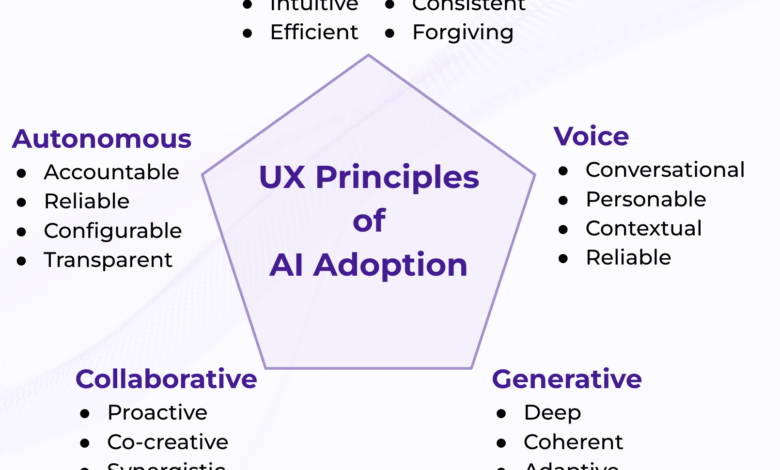
The AI industry faces a sobering reality: despite billions in investment, most AI initiatives fail to deliver measurable business impact. McKinsey’s 2025 research reveals that more than 80 percent of organizations aren’t seeing a tangible impact on enterprise-level EBIT from their use of generative AI.
This isn’t a technology failure, it’s a strategic oversight that’s costing companies millions in unrealized potential.
The culprit? Organizations are assuming AI will be adopted simply by making it available when, in reality, it’s fundamentally a user experience roadblock.
The companies achieving transformational AI ROI aren’t necessarily those with the most sophisticated algorithms. They’re the ones that understand how different AI technologies require distinct UX approaches, each with evolved principles that drive adoption, engagement, and business value.
Technology shapes UX principles
Each AI interaction type—from traditional interfaces to voice, generative text, collaborative systems, and autonomous agents—demands its own specialized UX approach. Organizations that recognize this pattern and adapt their design principles accordingly see dramatically higher ROI from their AI investments.
The key insight: there’s no one-size-fits-all UX strategy for AI.
GUI: Original UX principles
Desktop and mobile AI applications that rely on visual interfaces require UX principles rooted in decades of proven best practices. These foundational principles are essential for any AI system that uses traditional screen-based interactions.
Intuitive navigation eliminates training costs and reduces time-to-value. When users can interact with AI features without extensive onboarding, adoption rates increase 40-60% compared to complex interfaces. Efficient task completion minimizes friction and maximizes productivity gains. Consistent behavior across touchpoints builds user confidence and reduces support overhead. Forgiving error handling prevents user abandonment and maintains engagement during the inevitable mistakes that occur during AI learning curves.
Netflix’s recommendation system exemplifies these principles perfectly. Users receive AI-powered suggestions without needing to understand the underlying collaborative filtering algorithms. The interface feels familiar and predictable, driving high engagement rates that translate to reduced churn and increased subscription revenue.
Voice interface AI: Conversational principles
Voice-activated AI systems like Alexa introduced entirely new UX requirements that couldn’t rely on visual cues or traditional interface elements. The success of voice AI—with 82% household penetration and generating billions in revenue—demonstrates how UX principles unlock massive market opportunities.
Contextual understanding allows AI to interpret situational nuances without explicit user instruction, dramatically reducing cognitive load. Natural conversation flow leverages human communication patterns rather than forcing users to learn artificial command structures. Reliable voice recognition builds trust through consistent performance across accents and environments. Personable interaction creates an emotional connection that drives long-term usage and brand loyalty.
The business impact is substantial: companies implementing voice AI with these principles report 3-5x higher engagement rates and significantly lower customer acquisition costs. Smart home companies using voice interfaces see average revenue per user increases of 25-40% compared to app-only competitors.
Generative AI: Complexity management principles
Large language models and generative AI tools introduced unprecedented capabilities but also created new UX challenges around managing complexity and building trust in AI-generated content. Organizations that master these specialized principles capture disproportionate value from generative AI investments.
Deep understanding enables AI to provide comprehensive, in-depth information without hallucinating or fabricating details when knowledge isn’t available. Coherent language output ensures responses make logical sense and maintain clear communication throughout complex interactions. Adaptive personalization allows systems to learn from user feedback and customize responses based on individual preferences and usage patterns. Iterative refinement supports back-and-forth collaboration, enabling users to guide and improve AI outputs through multiple exchanges.
GitHub Copilot demonstrates the ROI potential when these principles are properly implemented. By understanding code context deeply and maintaining consistency across suggestions, it drives 55% productivity improvements and 88% user satisfaction rates. This translates to measurable subscription revenue growth and customer retention that significantly exceeds traditional development tools.
Collaborative AI: Partnership principles
AI systems designed for creative collaboration require UX principles that preserve human agency while amplifying capabilities. This interaction type represents the frontier of AI design, where the most innovative companies are capturing competitive advantages through superior user experience.
Proactive assistance anticipates user needs based on workflow patterns, reducing friction and increasing task completion rates by 30-50%. Co-creative enablement facilitates true partnership between humans and AI, unlocking innovation that neither could achieve independently. Synergistic amplification ensures combined output quality exceeds individual capabilities. Workflow integration allows AI to understand team dynamics and project context without disrupting existing processes.
Design teams using AI collaboration tools with these principles report 2-3x higher creative output and significantly faster project completion times. The strategic advantage compounds: these organizations can tackle more complex challenges, serve end users/customers better, and innovate faster than competitors using AI as simple automation.
Autonomous AI: Trust and control principles
Self-operating AI systems—from autonomous vehicles to robotic process automation—require UX principles focused on trust, transparency, and user control. As these systems gain independence, the organizations that solve these UX challenges first will capture the largest market opportunities.
Accountable decision-making provides clear audit trails and responsibility chains that satisfy regulatory requirements and user expectations. Reliable performance in high-stakes scenarios builds confidence for broader deployment across business-critical functions. Configurable parameters allow customization for diverse use cases while maintaining system integrity. Transparent operations enable real-time monitoring and verification of AI decisions.
Waymo’s autonomous vehicle UX exemplifies the business impact: 88% reduction in property damage claims and 92% reduction in bodily injury claims compared to human drivers. This performance advantage leads to lower insurance costs, reduced liability exposure, and higher customer satisfaction—all driving substantial business value and market differentiation.
Strategic implementation: Matching UX principles to AI technologies
The evidence demonstrates that organizations achieving superior AI ROI consistently match their UX approach to their specific AI interaction type. This isn’t about choosing one set of principles. It’s about applying the right principles for each AI touchpoint in an organization.
Invest in interaction-specific user research. Understanding how your audience naturally interacts with each AI technology enables targeted UX investments that deliver measurable returns. Organizations that research user behavior across different AI interaction types see adoption rates 40% higher than those using generic UX approaches.
Build measurement frameworks for each technology. Voice AI success metrics differ fundamentally from generative AI metrics, which differ from autonomous AI metrics. The most successful implementations track technology-appropriate indicators: conversation completion rates for voice, output quality for generative, trust scores for autonomous systems.
Plan evolution strategically across technologies. Rather than treating all AI investments equally, successful organizations prioritize UX improvements based on business impact potential and user readiness for each interaction type.
The competitive advantage of technology-aware AI UX
As AI capabilities become commoditized across providers, UX design becomes the primary differentiator for business success. Organizations that understand how to match UX principles to different AI technologies create sustainable competitive advantages that compound over time.
The opportunity is significant but requires immediate action. Early movers in technology-specific AI UX design are establishing market positions that will become increasingly difficult for competitors to challenge. The companies that recognize AI interaction diversity and adapt their UX strategies accordingly will capture disproportionate value as the AI economy matures.
Success belongs to organizations that don’t just deploy AI. They craft technology-appropriate experiences that users genuinely want to adopt and depend on for their most important work.
Eric Karofsky is an award-winning CX, UX, and employee engagement industry expert who leads VectorHX, a human experience agency. VectorHX partners with companies to analyze and enhance customer experiences that build loyalty and design user experiences that delight. Eric has led CX and UX projects for more than 20 years with brands and agencies for companies like Fidelity, The Hartford, Royal Caribbean, Michelin, Reebok, and the National Institutes of Health.


